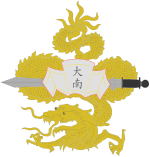House of Representatives (Annam)
- Machine translation, like DeepL or Google Translate, is a useful starting point for translations, but translators must revise errors as necessary and confirm that the translation is accurate, rather than simply copy-pasting machine-translated text into the English Wikipedia.
- Do not translate text that appears unreliable or low-quality. If possible, verify the text with references provided in the foreign-language article.
- You must provide copyright attribution in the edit summary accompanying your translation by providing an interlanguage link to the source of your translation. A model attribution edit summary is
Content in this edit is translated from the existing Vietnamese Wikipedia article at [[:vi:Viện Dân biểu Trung Kỳ]]; see its history for attribution. - You may also add the template
{{Translated|vi|Viện Dân biểu Trung Kỳ}}to the talk page. - For more guidance, see Wikipedia:Translation.
Trung kỳ Nhân dân Đại biểu viện 中圻人民代表院 Chambre des Représentants du Peuple de l'Annam | |
|---|---|
 | |
| Type | |
| Type | Unicameral |
| History | |
| Established | February 24, 1926 |
| Disbanded | May 12, 1945 |
| Preceded by | Indigenous Consultative Council |
| Seats | 33 |
| Meeting place | |
 | |
| Huế, Annam, French Indochina | |
The House of Representatives of the People of Annam (Vietnamese: Trung kỳ Nhân dân Đại biểu viện, Hán-Nôm: 中圻人民代表院, French: Chambre des Représentants du Peuple de l'Annam) was an advisory body for the French Indochinese colonial government in the protectorate of Annam (nowadays Central Vietnam). It was involved with economic, financial and social issues of the protectorate. The chamber was established by a decree on February 24, 1926, of Governor-General of Indochina Alexandre Varenne. The predecessor of the chamber was the Indigenous Consultative Council of Annam (Vietnamese: Hội đồng Tư vấn Bản xứ Trung Kỳ, French: Chambre consultative Indigène l’Annam). The body officially ceased its operation on May 12, 1945, after a decree of dissolution by Emperor Bảo Đại following the Japanese coup d'état against the French colonial authorities in Indochina.
Prominent figures of the Vietnamese independence and anti-colonial movements had been members of the house, most notably Huỳnh Thúc Kháng, who was the President of the House of Representatives (1926-1928) and later became the Acting President of the Democratic Republic of Vietnam.[1][2]
Organization
There were 33 deputies to the House of Representatives, headed by a president. The constituency is limited to one of these six categories:
- civil servants
- university graduates
- cai tổng (heads of local communes)
- delegates of local councils selected by the Privy Council
- mandarins
- businessmen with high tax bracket
List of presidents
- Huỳnh Thúc Kháng (1926-1928)[2]
- Nguyễn Trác
- Nguyễn Phúc Ưng Bình (1940-1945)
Seat
The former seat of the House of Representatives has been used as administrative offices for the University of Huế.[3]
References
- ^ Hemery, Daniel (1977). "Aux origines des guerres d'indépendance vietnamiennes: pouvoir colonial et phénomène communiste en Indochine avant la Seconde Guerre mondiale". Le Mouvement social (101): 35. doi:10.2307/3777877. ISSN 0027-2671.
- ^ a b Hồng, Khanh (2015-06-21). "Tiêng Dân, la voix du peuple sous la colonisation française". Le Courrier du Vietnam (in French). Retrieved 2022-10-10.
- ^ "Direction de l’Université de Hué, anciennement Chambre des réprésentants du peuple"
External links
 Media related to House of People's Representatives (French protectorate of Annam) at Wikimedia Commons
Media related to House of People's Representatives (French protectorate of Annam) at Wikimedia Commons
- v
- t
- e
territories
- French assistance to Nguyễn Ánh (1777–1820)
- Lê Văn Khôi revolt (1833–35)
- Bombardment of Tourane (1847)
- French conquest of Vietnam
- Sino-French War (1884–1885)
- Franco-Siamese crisis (1893)
- Holy Man's Rebellion (1901-1936)
- World War I
- 1916 Cochinchina uprising
- Thái Nguyên uprising
- Vue Pa Chay's revolt
- Bazin assassination
- Yên Bái mutiny
- World War II
- French–Thai War (1940–1941)
- Japanese invasion of French Indochina
- Japanese coup d'état in French Indochina
- August Revolution
- Proclamation of Independence of the Democratic Republic of Vietnam
- French Permanent Military Tribunal in Saigon
- First Indochina War
- Battle of Dien Bien Phu
- Partition of Vietnam
- Treaty of Versailles (1787)
- Treaty of Saigon (1862)
- Treaty of Huế (1863)
- Treaty of Saigon (1874)
- Treaty of Huế (1883)
- Treaty of Huế (1884)
- Treaty of Tientsin (1885)
- Geneva Conference (1954)
personalities













